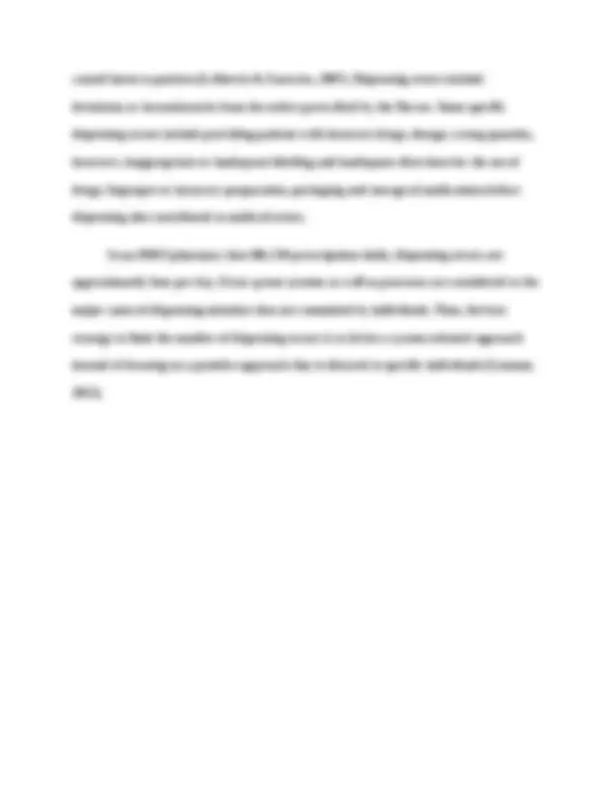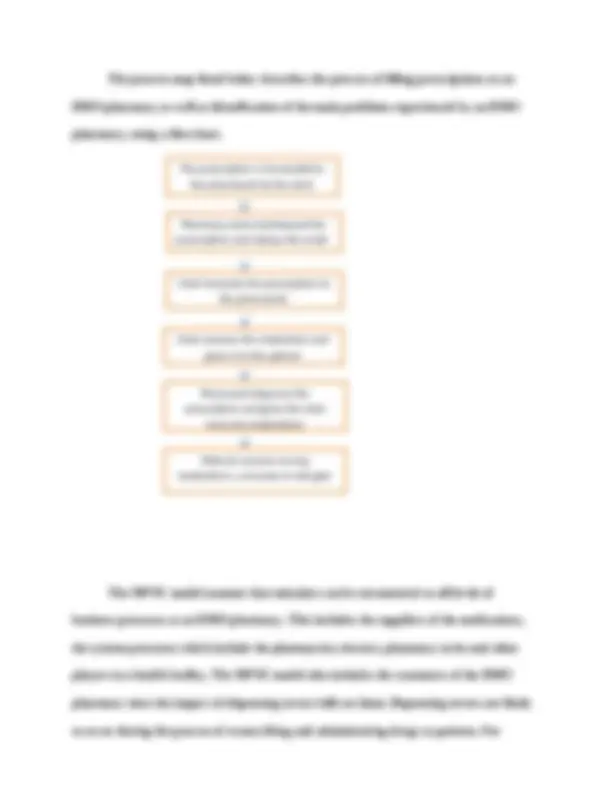





Study with the several resources on Docsity

Earn points by helping other students or get them with a premium plan


Prepare for your exams
Study with the several resources on Docsity

Earn points to download
Earn points by helping other students or get them with a premium plan
Community
Ask the community for help and clear up your study doubts
Discover the best universities in your country according to Docsity users
Free resources
Download our free guides on studying techniques, anxiety management strategies, and thesis advice from Docsity tutors
Case Study 1: Statistical Thinking in Health Care MAT 510: Business Statistics Strayer University
Typology: Exams
1 / 7

This page cannot be seen from the preview
Don't miss anything!




Case Study 1: Statistical Thinking in Health To provide an explanation of the possible prescription errors that is being dispensed to an HMO’s pharmacy, I will assume the role of Ben Davis. I will start by developing a process map which will outline the flow of activities performed in filling prescriptions in a HMO pharmacy. I will then apply the SIPOC (supplier, input, process,
and Customer) model to evaluate business process utilized by the HMO’s pharmacy. The third step will involve an analysis of the SIPOC model and the process map so as to determine the primary causes of the problem after which I will then categorize these possible primary causes as either common causes or special causes. In the fourth step, I will specify the main tools and data to be collected to assess the problem and correct it. Lastly, I will propose a solution to the problems identified and provide a strategy of how the solution suggested can be solved. An analysis of this study case will be helpful in addressing the common problems that surround the inaccurate prescriptions at the common problems made at the HMO pharmacies. Patients are required to use a pharmacy that is usually located in the same area with the HMO, or they may be required to visit certain pharmacies as directed by their physicians. Some insurance companies have contracts with certain drug stores and therefore if the patient is covered by such an insurance company he/she may be forced to use a particular pharmacy as directed by the insurance company. Medication errors are considered to be one of the leading causes of mortality in the U.S. Approximately 21% of all these medical errors are dispensing errors. Dispensing errors are not only traumatic for pharmacists but also affects the patients. As a result, the aim of every pharmacy is to limit the amount of dispensing errors. The good news is that only two-thirds of the reported dispensing errors reach the patients and only a few cases have been reported to have
The process map listed below describes the process of filling prescriptions at an HMO pharmacy as well as identification of the main problems experienced by an HMO pharmacy, using a flowchart. The SIPOC model assumes that mistakes can be encountered at all levels of business processes at an HMO pharmacy. This includes the suppliers of the medications, the system processes which include the pharmacists, doctors, pharmacy techs and other players in a health facility. The SIPOC model also includes the customers of the HMO pharmacy since the impact of dispensing errors falls on them. Dispensing errors are likely to occur during the process of transcribing and administering drugs to patients. For The prescription is forwarded to the pharmacist by the clerk Pharmacy clerk misinterpret the prescription and stamps the order Clerk forwards the prescription to the pharmacist Clerk receives the medication and gives it to the patient Pharmacist dispense the prescription and gives the clerk incorrect medications Patients receives wrong medications, consumes it and gets
example, the pharmacy technologist can enter the wrong prescription. This problem can be solved by the patient’s identifiers who should be in a position of ruling out wrong medications that are being given to customers. They can do
References Gautam, P. (2013). Minimizing medication errors: Moving attention from individual to system. Journal of Anaesthesiology Clinical Pharmacology , 29 (3), 293. doi:10.4103/0970-9185. Lefkovitz, A., & Zarowitz, B. (2007). Top 10 Lists—Medications Associated with Adverse Events and Medications Involved with Errors. Geriatric Nursing , 28 (5), 276-279. doi:10.1016/j.gerinurse.2007.08.